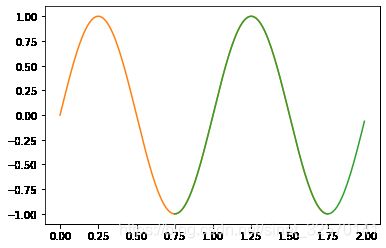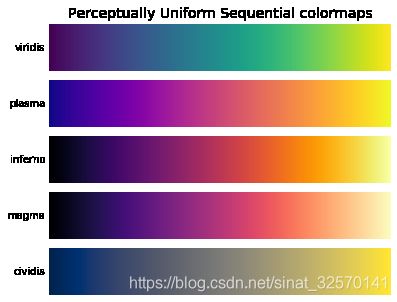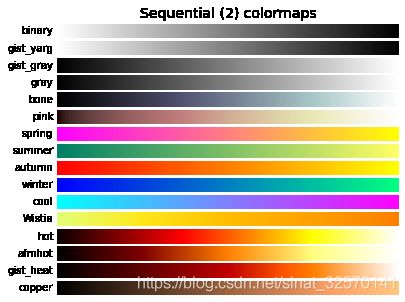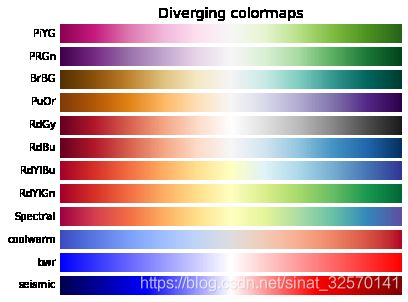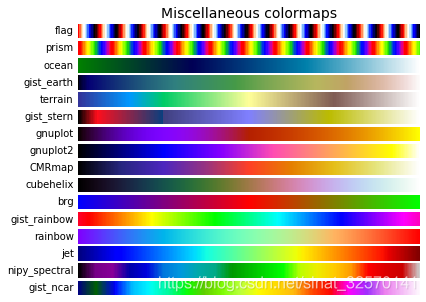matplotlib 配色之内置 colormap
Matplotlib 配色之内置 colormap
概述
让图表看起来比较美观是图表配色最末的目的,配色最核心的目标是为你的数据集找到一个好的表达。
对于任何给定的数据集,最佳的配色取决于许多因素,包括:
- 表现形式或者度量数据。
- 你对数据集的理解(如:是否有一个偏离其它值的临界值?)
- 如果你正在绘制的参数(变量本身)有一个直观的配色方案
- 如果在这个领域有一个标准(行业配色标准或习惯),读者可能会期待
对于许多应用程序,感知上一致的配色是最佳选择。如,数据中的相同步幅被视为颜色空间中的相同步幅(色彩间的变化反映了数据的变化)。
感知是观众对不同颜色、或不同颜色组合的情感反应。
matplotlib提供了三个模块用于对图表的颜色进行操控:
- matplotlib.cm
- matplotlib.colorbar
- matplotlib.colors
在matplotlib中,有三种给图表配色的方法:
- 直观的指定颜色,如,在对象的参数中指定,
color='red'; - 使用colormap,将数据映射为颜色模型。注意,需要支持 cmap 参数的图表类型;
- 通过y值,使用蒙版数组按y值绘制具有不同颜色的线。
前面的文章已详细介绍了 方法1、2,下面用一个示例介绍方法3。
使用masked arrays组线条着不同的颜色
%matplotlib inline
import numpy as np
import matplotlib.pyplot as plt
t = np.arange(0.0, 2.0, 0.01)
s = np.sin(2 * np.pi * t)
upper = 0.77
lower = -0.77
supper = np.ma.masked_where(s < upper, s)
slower = np.ma.masked_where(s > lower, s)
smiddle = np.ma.masked_where((s < lower) | (s > upper), s)
fig, ax = plt.subplots()
ax.plot(t, smiddle, t, slower, t, supper)
plt.show()
%matplotlib inline
import numpy as np
import matplotlib.pyplot as plt
t = np.arange(0.0, 2.0, 0.01)
s = np.sin(2 * np.pi * t)
upper =0.75
lower = 1.75
supper = np.ma.masked_where(t < upper, s)
slower = np.ma.masked_where(t > lower, s)
smiddle = np.ma.masked_where((t < lower) | (t > upper), t)
fig, ax = plt.subplots()
ax.plot(t, smiddle, t, slower, t, supper)
plt.show()
matplotlib内置的colormap
matplotlib内置了7类colormap,用于不同的场景:
- Perceptually Uniform Sequential
- Sequential
- Sequential2
- Diverging
- Cyclic
- Qualitative
- Miscellaneous
Perceptually Uniform Sequential
Sequential,顺序排列的,连续、有序的。
明度、亮度的变化,通常是颜色的饱和度逐渐增加,经常使用单一的色相;适合用于表示具有顺序的信息。
"Perceptually Uniform Sequential"类colormap提供了5种数值到颜色的映射序列,左边是亮度较低(亮度较暗的色相),右边则是较亮的色相。
cmaps['Perceptually Uniform Sequential'] = [
'viridis', 'plasma', 'inferno', 'magma', 'cividis']
from colorspacious import cspace_convert
# sphinx_gallery_thumbnail_number = 2
import numpy as np
import matplotlib as mpl
import matplotlib.pyplot as plt
from matplotlib import cm
from colorspacious import cspace_converter
from collections import OrderedDict
cmaps = OrderedDict()
cmaps['Perceptually Uniform Sequential'] = [
'viridis', 'plasma', 'inferno', 'magma', 'cividis']
nrows = max(len(cmap_list) for cmap_category, cmap_list in cmaps.items())
gradient = np.linspace(0, 1, 256)
gradient = np.vstack((gradient, gradient))
def plot_color_gradients(cmap_category, cmap_list, nrows):
fig, axes = plt.subplots(nrows=nrows)
fig.subplots_adjust(top=0.95, bottom=0.01, left=0.2, right=0.99)
axes[0].set_title(cmap_category + ' colormaps', fontsize=14)
for ax, name in zip(axes, cmap_list):
ax.imshow(gradient, aspect='auto', cmap=plt.get_cmap(name))
pos = list(ax.get_position().bounds)
x_text = pos[0] - 0.01
y_text = pos[1] + pos[3]/2.
fig.text(x_text, y_text, name, va='center', ha='right', fontsize=10)
# Turn off *all* ticks & spines, not just the ones with colormaps.
for ax in axes:
ax.set_axis_off()
for cmap_category, cmap_list in cmaps.items():
plot_color_gradients(cmap_category, cmap_list, nrows)
plt.show()
print(cmaps)
OrderedDict([('Perceptually Uniform Sequential', ['viridis', 'plasma', 'inferno', 'magma', 'cividis'])])
获取colormap颜色信息
以RGB颜色为例,colormap每个映射使用一个(256,3),即256行,3列的array存储颜色信息。每行代表colormap映射条上的一个点。
可以使用下面的代码读取cmp的颜色信息:
#读取cmp单个点的颜色的RGB值
from matplotlib import cm
def get_pcv(cn,r):
#cn是cmap实例,例如 cn = cm.viridis, cm=cm.jet
#r是行号,整数,如12
print(cn(r)[0],cn(r)[1],cn(r)[2])
#转换为256色表示的整数
print(int(cn(r)[0]*255.0),int(cn(r)[1]*255.0),int(cn(r)[2]*255.0))
piyg_l = [x for x in cm.PiYG._segmentdata['green']]
def prc(cmap):
for y in cmap:
for l in y:
print(l*255)
prc(piyg_l)
#print(len(piyg_l))
#print(piyg_l)
0.0
1.0
1.0
25.5
27.0
27.0
51.0
119.0
119.0
76.50000000000001
182.0
182.0
102.0
224.0
224.0
127.5
247.0
247.0
153.00000000000003
245.0
245.0
178.50000000000003
225.0
225.0
204.0
188.0
188.0
229.5
146.0
146.0
255.0
100.0
100.0
bwr_l = [x*255 for x in cm.bwr._segmentdata['green'][2]]
print(len(bwr_l))
print(bwr_l)
3
[255.0, 0.0, 0.0]
get_pcv(cm.viridis,0)
0.267004 0.004874 0.329415
68 1 84
每个colormap实例都有一个name属性,返回映射的名称。
from matplotlib import cm
cn = cm.viridis
cn.name
'viridis'
获取colormap实例的映射值
如此众多的colormaps,使用下面的代码,可以将这些colormap中具体的数值导出来,以供更深入地研究、更灵活地使用。
#获取colormap实例的映射值
from matplotlib import cm
def get_cmv(cn):
#cn是colormap的实例,如cm.viridis, cm.jet等
import numpy as np
#创建全部为0的(256,3)的数组
colormap_int = np.zeros((256, 3), np.uint8)
colormap_float = np.zeros((256, 3), np.float)
#将每个点值读取,存入上面的数组
for i in range(0, 256, 1):
colormap_float[i, 0] = cn(i)[0]
colormap_float[i, 1] = cn(i)[1]
colormap_float[i, 2] = cn(i)[2]
colormap_int[i, 0] = np.int_(np.round(cn(i)[0] * 255.0))
colormap_int[i, 1] = np.int_(np.round(cn(i)[1] * 255.0))
colormap_int[i, 2] = np.int_(np.round(cn(i)[2] * 255.0))
#将数组保存到txt文件
np.savetxt(str(cn.name)+"_float.txt", colormap_float, fmt = "%f", delimiter = ' ', newline = '\n')
np.savetxt(str(cn.name)+"_int.txt", colormap_int, fmt = "%d", delimiter = ' ', newline = '\n')
#打印相关信息
#print(colormap_int)
print(colormap_int.shape)
print(colormap_int)
return
#调用get_cmv()函数,提供colormap实例作为参数
get_cmv(cm.viridis)
(256, 3)
[[ 68 1 84]
[ 68 2 86]
[ 69 4 87]
[ 69 5 89]
[ 70 7 90]
[ 70 8 92]
[ 70 10 93]
[ 70 11 94]
[ 71 13 96]
[ 71 14 97]
[ 71 16 99]
[ 71 17 100]
[ 71 19 101]
[ 72 20 103]
[ 72 22 104]
[ 72 23 105]
[ 72 24 106]
[ 72 26 108]
[ 72 27 109]
[ 72 28 110]
[ 72 29 111]
[ 72 31 112]
[ 72 32 113]
[ 72 33 115]
[ 72 35 116]
[ 72 36 117]
…
Sequential,
对于序列图,亮度值通过颜色图单调增加。
colormaps中的一些 L ∗ L^∗ L∗ 值(亮度值)的范围是从0到100(二进制和其他灰度级),其他的在 L ∗ = 20 L^∗ =20 L∗=20 左右开始。 L ∗ L^∗ L∗ 函数在colormap之间是不同的:有些在 L ∗ L^∗ L∗ 中是近线性的,而其他的则是较为弯曲的。
Sequential类colormap有如下特性:
- 通常是单一色相的亮度变化;
- 亮度值变化范围从0到100;
- 有些是线性变化的,有些则是曲线的;
- 同一色相有亮度变化,不同色相之间的亮度不同。
# sphinx_gallery_thumbnail_number = 2
import numpy as np
import matplotlib as mpl
import matplotlib.pyplot as plt
from matplotlib import cm
from colorspacious import cspace_converter
from collections import OrderedDict
cmaps = OrderedDict()
cmaps['Sequential'] = [
'Greys', 'Purples', 'Blues', 'Greens', 'Oranges', 'Reds',
'YlOrBr', 'YlOrRd', 'OrRd', 'PuRd', 'RdPu', 'BuPu',
'GnBu', 'PuBu', 'YlGnBu', 'PuBuGn', 'BuGn', 'YlGn']
nrows = max(len(cmap_list) for cmap_category, cmap_list in cmaps.items())
gradient = np.linspace(0, 1, 256)
gradient = np.vstack((gradient, gradient))
for cmap_category, cmap_list in cmaps.items():
plot_color_gradients(cmap_category, cmap_list, nrows)
plt.show()
print(cmaps)
OrderedDict([('Sequential', ['Greys', 'Purples', 'Blues', 'Greens', 'Oranges', 'Reds', 'YlOrBr', 'YlOrRd', 'OrRd', 'PuRd', 'RdPu', 'BuPu', 'GnBu', 'PuBu', 'YlGnBu', 'PuBuGn', 'BuGn', 'YlGn'])])
Sequential2
Sequential2类别中许多颜色映射模型的 L ∗ L^∗ L∗ 值都是单调增加的,但是某些映射模型 (autumn, cool, spring, and winter) 在 L ∗ L^∗ L∗ 空间中达到平稳,或者甚至上下波动。其它映射模型(afmhot, copper, gist_heat, and hot) 在 L ∗ L^∗ L∗ 函数中有纽结。在平稳或扭结的colormap区域中表示的数据将在colormap的这些值处导致数据条带的感觉。
# sphinx_gallery_thumbnail_number = 2
import numpy as np
import matplotlib as mpl
import matplotlib.pyplot as plt
from matplotlib import cm
from colorspacious import cspace_converter
from collections import OrderedDict
cmaps = OrderedDict()
cmaps['Sequential (2)'] = [
'binary', 'gist_yarg', 'gist_gray', 'gray', 'bone', 'pink',
'spring', 'summer', 'autumn', 'winter', 'cool', 'Wistia',
'hot', 'afmhot', 'gist_heat', 'copper']
nrows = max(len(cmap_list) for cmap_category, cmap_list in cmaps.items())
gradient = np.linspace(0, 1, 256)
gradient = np.vstack((gradient, gradient))
for cmap_category, cmap_list in cmaps.items():
plot_color_gradients(cmap_category, cmap_list, nrows)
plt.show()
print(cmaps)
OrderedDict([('Sequential (2)', ['binary', 'gist_yarg', 'gist_gray', 'gray', 'bone', 'pink', 'spring', 'summer', 'autumn', 'winter', 'cool', 'Wistia', 'hot', 'afmhot', 'gist_heat', 'copper'])])
Diverging 发散
对于 Diverging 映射,我们希望 L ∗ L^∗ L∗ 值单调增加到最大值,该值应接近 L ∗ = 100 L^∗ = 100 L∗=100, 然后单调减小 L ∗ L^∗ L∗ 值。我们在colormap的相对两端寻找近似相等的最小 L ∗ L^∗ L∗ 值。通过这些措施,BrBG and RdBu 是不错的选择。coolwarm 是一个不错的选择,但它不能涵盖范围广泛的 L ∗ L^∗ L∗ 值 。
# sphinx_gallery_thumbnail_number = 2
import numpy as np
import matplotlib as mpl
import matplotlib.pyplot as plt
from matplotlib import cm
from colorspacious import cspace_converter
from collections import OrderedDict
cmaps = OrderedDict()
cmaps['Diverging'] = [
'PiYG', 'PRGn', 'BrBG', 'PuOr', 'RdGy', 'RdBu',
'RdYlBu', 'RdYlGn', 'Spectral', 'coolwarm', 'bwr', 'seismic']
nrows = max(len(cmap_list) for cmap_category, cmap_list in cmaps.items())
gradient = np.linspace(0, 1, 256)
gradient = np.vstack((gradient, gradient))
for cmap_category, cmap_list in cmaps.items():
plot_color_gradients(cmap_category, cmap_list, nrows)
plt.show()
print(cmaps)
OrderedDict([('Diverging', ['PiYG', 'PRGn', 'BrBG', 'PuOr', 'RdGy', 'RdBu', 'RdYlBu', 'RdYlGn', 'Spectral', 'coolwarm', 'bwr', 'seismic'])])
Cyclic 循环的
对于循环的映射,我们希望以相同的颜色开始和结束,并在中间遇到一个对称的中心点。 L ∗ L^∗ L∗ 应该从开始到中间单调变化,再从中间到结尾反向单调变化。它在增加和减少方面应该是对称的,并且只有色相不同。在两端和中间, L ∗ L^∗ L∗ 将反转方向,应在 L ∗ L^∗ L∗ 区间中进行平滑处理以减少伪像。
尽管此HSV颜色映射与中心点不对称,但它仍包含在这组颜色映射中。此外, L ∗ L^∗ L∗ 值在整个颜色映射中变化很大,因此对于表示供观看者感知的数据而言,这是一个糟糕的选择。请在 mycarta-jet上查看有关此想法的扩展。
# sphinx_gallery_thumbnail_number = 2
import numpy as np
import matplotlib as mpl
import matplotlib.pyplot as plt
from matplotlib import cm
from colorspacious import cspace_converter
from collections import OrderedDict
cmaps = OrderedDict()
cmaps['Cyclic'] = ['twilight', 'twilight_shifted', 'hsv']
nrows = max(len(cmap_list) for cmap_category, cmap_list in cmaps.items())
gradient = np.linspace(0, 1, 256)
gradient = np.vstack((gradient, gradient))
for cmap_category, cmap_list in cmaps.items():
plot_color_gradients(cmap_category, cmap_list, nrows)
plt.show()
print(cmaps)
OrderedDict([('Cyclic', ['twilight', 'twilight_shifted', 'hsv'])])
Qualitative 定性
定性的 colormaps L ∗ L^∗ L∗ 值在colormap上四处移动,显然不是单调递增的。
# sphinx_gallery_thumbnail_number = 2
import numpy as np
import matplotlib as mpl
import matplotlib.pyplot as plt
from matplotlib import cm
from colorspacious import cspace_converter
from collections import OrderedDict
cmaps = OrderedDict()
cmaps['Qualitative'] = ['Pastel1', 'Pastel2', 'Paired', 'Accent',
'Dark2', 'Set1', 'Set2', 'Set3',
'tab10', 'tab20', 'tab20b', 'tab20c']
nrows = max(len(cmap_list) for cmap_category, cmap_list in cmaps.items())
gradient = np.linspace(0, 1, 256)
gradient = np.vstack((gradient, gradient))
for cmap_category, cmap_list in cmaps.items():
plot_color_gradients(cmap_category, cmap_list, nrows)
plt.show()
print(cmaps)
OrderedDict([('Qualitative', ['Pastel1', 'Pastel2', 'Paired', 'Accent', 'Dark2', 'Set1', 'Set2', 'Set3', 'tab10', 'tab20', 'tab20b', 'tab20c'])])
Miscellaneous 杂项
一些杂项 colormaps 有其特定用途。例如,gist_earth, ocean, and terrain 似乎都是为一起绘制地形 topography (green/brown) 和水深 (blue) 而创建的。我们期望在这些 colormaps 看到一个(气流或海洋的)分开处, 然而,但是在gist_earth和地形中,多种扭结可能不是最理想的。创建CMRmap是为了很好地转换为灰度。尽管它在 L ∗ L^* L∗中似乎存在一些小问题。立方体螺旋被创造在亮度和色调上平滑地变化,但是在绿色色调区域似乎有一个小隆起。
常用的jet colormap包含在这组colormap中。我们可以看到, L ∗ L^* L∗值在整个colormap中变化很大,这使得它成为一个糟糕的选择,不能代表查看者能够感知到的数据。在mycarta-jet可以看到这个想法的扩展。
# sphinx_gallery_thumbnail_number = 2
import numpy as np
import matplotlib as mpl
import matplotlib.pyplot as plt
from matplotlib import cm
from colorspacious import cspace_converter
from collections import OrderedDict
cmaps = OrderedDict()
cmaps['Miscellaneous'] = [
'flag', 'prism', 'ocean', 'gist_earth', 'terrain', 'gist_stern',
'gnuplot', 'gnuplot2', 'CMRmap', 'cubehelix', 'brg',
'gist_rainbow', 'rainbow', 'jet', 'nipy_spectral', 'gist_ncar']
nrows = max(len(cmap_list) for cmap_category, cmap_list in cmaps.items())
gradient = np.linspace(0, 1, 256)
gradient = np.vstack((gradient, gradient))
for cmap_category, cmap_list in cmaps.items():
plot_color_gradients(cmap_category, cmap_list, nrows)
plt.show()
print(cmaps)
OrderedDict([('Miscellaneous', ['flag', 'prism', 'ocean', 'gist_earth', 'terrain', 'gist_stern', 'gnuplot', 'gnuplot2', 'CMRmap', 'cubehelix', 'brg', 'gist_rainbow', 'rainbow', 'jet', 'nipy_spectral', 'gist_ncar'])])
colormap可用的映射名称
内置的映射名称
matplotlib内置了7类,82种颜色映射,每种颜色映射又有一个反向映射,共164种。
当使用cm.get_cmap(name)方法返回内置的colormap实例时,如果name参数不在内置的映射中,就会触发如下错误,并提示可用的名称:
ValueError: Colormap NoNmae is not recognized. Possible values are:
下面的代码就会触发上述错误:
%matplotlib inline
import matplotlib as mpl
cmap = mpl.cm.get_cmap('noname')
可用的名称值有:
| 1 | 2 | 3 | 4 | 5 | 6 |
|---|---|---|---|---|---|
| Accent | Accent_r | Blues | Blues_r | BrBG | BrBG_r |
| BuGn | BuGn_r | BuPu | BuPu_r | CMRmap | CMRmap_r |
| Dark2 | Dark2_r | GnBu | GnBu_r | Greens | Greens_r |
| Greys | Greys_r | OrRd | OrRd_r | Oranges | Oranges_r |
| PRGn | PRGn_r | Paired | Paired_r | Pastel1 | Pastel1_r |
| Pastel2 | Pastel2_r | PiYG | PiYG_r | PuBu | PuBuGn |
| PuBuGn_r | PuBu_r | PuOr | PuOr_r | PuRd | PuRd_r |
| Purples | Purples_r | RdBu | RdBu_r | RdGy | RdGy_r |
| RdPu | RdPu_r | RdYlBu | RdYlBu_r | RdYlGn | RdYlGn_r |
| Reds | Reds_r | Set1 | Set1_r | Set2 | Set2_r |
| Set3 | Set3_r | Spectral | Spectral_r | Wistia | Wistia_r |
| YlGn | YlGnBu | YlGnBu_r | YlGn_r | YlOrBr | YlOrBr_r |
| YlOrRd | YlOrRd_r | afmhot | afmhot_r | autumn | autumn_r |
| binary | binary_r | bone | bone_r | brg | brg_r |
| bwr | bwr_r | cividis | cividis_r | cool | cool_r |
| coolwarm | coolwarm_r | copper | copper_r | cubehelix | cubehelix_r |
| flag | flag_r | gist_earth | gist_earth_r | gist_gray | gist_gray_r |
| gist_heat | gist_heat_r | gist_ncar | gist_ncar_r | gist_rainbow | gist_rainbow_r |
| gist_stern | gist_stern_r | gist_yarg | gist_yarg_r | gnuplot | gnuplot2 |
| gnuplot2_r | gnuplot_r | gray | gray_r | hot | hot_r |
| hsv | hsv_r | inferno | inferno_r | jet | jet_r |
| magma | magma_r | nipy_spectral | nipy_spectral_r | ocean | ocean_r |
| pink | pink_r | plasma | plasma_r | prism | prism_r |
| rainbow | rainbow_r | seismic | seismic_r | spring | spring_r |
| summer | summer_r | tab10 | tab10_r | tab20 | tab20_r |
| tab20b | tab20b_r | tab20c | tab20c_r | terrain | terrain_r |
| twilight | twilight_r | twilight_shifted | twilight_shifted_r | viridis | viridis_r |
| winter | winter_r |
获取颜色映射分类及名称
from collections import OrderedDict
in_cmaps = OrderedDict()
in_cmaps['Perceptually Uniform Sequential'] = [
'viridis', 'plasma', 'inferno', 'magma', 'cividis']
in_cmaps['Sequential'] = [
'Greys', 'Purples', 'Blues', 'Greens', 'Oranges', 'Reds',
'YlOrBr', 'YlOrRd', 'OrRd', 'PuRd', 'RdPu', 'BuPu',
'GnBu', 'PuBu', 'YlGnBu', 'PuBuGn', 'BuGn', 'YlGn']
in_cmaps['Sequential (2)'] = [
'binary', 'gist_yarg', 'gist_gray', 'gray', 'bone', 'pink',
'spring', 'summer', 'autumn', 'winter', 'cool', 'Wistia',
'hot', 'afmhot', 'gist_heat', 'copper']
in_cmaps['Diverging'] = [
'PiYG', 'PRGn', 'BrBG', 'PuOr', 'RdGy', 'RdBu',
'RdYlBu', 'RdYlGn', 'Spectral', 'coolwarm', 'bwr', 'seismic']
in_cmaps['Cyclic'] = ['twilight', 'twilight_shifted', 'hsv']
in_cmaps['Qualitative'] = ['Pastel1', 'Pastel2', 'Paired', 'Accent',
'Dark2', 'Set1', 'Set2', 'Set3',
'tab10', 'tab20', 'tab20b', 'tab20c']
in_cmaps['Miscellaneous'] = [
'flag', 'prism', 'ocean', 'gist_earth', 'terrain', 'gist_stern',
'gnuplot', 'gnuplot2', 'CMRmap', 'cubehelix', 'brg',
'gist_rainbow', 'rainbow', 'jet', 'nipy_spectral', 'gist_ncar']
print(len(in_cmaps.get('Perceptually Uniform Sequential')))
5
for k in in_cmaps:
print(k+": ", len(in_cmaps.get(k)))
Perceptually Uniform Sequential: 5
Sequential: 18
Sequential (2): 16
Diverging: 12
Cyclic: 3
Qualitative: 12
Miscellaneous: 16
Demo
将使用有名的 Iris Data Set(鸢尾属植物数据集)中的数据来演示图表的绘制和配置,这样更接近实际的应用。可以到QQ群:457079928中下载这个数据集iris.csv。
Iris 数据集首次出现在著名的英国统计学家和生物学家Ronald Fisher 1936年的论文《The use of multiple measurements in taxonomic problems》中,被用来介绍线性判别式分析。
在这个数据集中,包括了三类不同的鸢尾属植物:Iris Setosa,Iris Versicolour,Iris Virginica。每类收集了50个样本,因此这个数据集一共包含了150个样本。
该数据集测量了 150 个样本的 4 个特征,分别是:
- sepal length(花萼长度)
- sepal width(花萼宽度)
- petal length(花瓣长度)
- petal width(花瓣宽度)
以上四个特征的单位都是厘米(cm)。
petal_l = iris_df['PetalLength'].values
sepal_l = iris_df['SepalLength'].values
norm = mpl.colors.Normalize(vmin=-2,vmax=10)
import matplotlib.pyplot as plt
from matplotlib.backends.backend_agg import FigureCanvasAgg
x = petal_l
y = sepal_l
fig = plt.figure()
ax= plt.axes()
color = x+y
plt.scatter(x, y, c=x/y)

